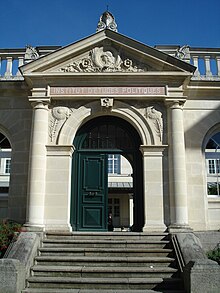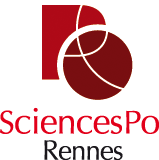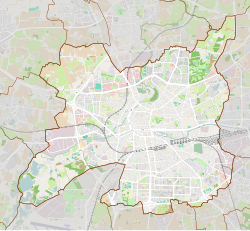Institut d'études politiques de Rennes
Institut d'études politiques de Rennes | |
 | |
| Type | Grande école Institut d'études politiques (public research university Political Science school) |
|---|---|
| Established | 1991[1] |
| Director | Pablo DIAZ[1] |
| Location | , 48°07′17″N 1°40′06″W / 48.121391°N 1.66834°W |
| Language | English-only & French-only instruction |
| Affiliations | Conférence des grandes écoles[1] Instituts d'études politiques[1] European University of Brittany |
| Website | www |
 | |
The Institut d'Etudes Politiques de Rennes (or "Rennes Institute of Political Studies") also known as Sciences Po Rennes, is a French university established in 1991 in Rennes, the regional capital of Brittany. The institution is one of 10 political science institutes in France and is considered one of the grandes écoles.[2]
History
[edit]Sciences Po Rennes was created by government decree in 1991 at the same time as Sciences Po Lille.[3]
Academics
[edit]Sciences Po institutes are Grandes Écoles, a French institution of higher education that is separate from, but parallel and connected to the main framework of the French public university system. Similar to the Ivy League in the United States, Oxbridge in the UK, and C9 League in China, Grandes Écoles are elite academic institutions that admit students through an extremely competitive process.[4][5][6] The selection rates at these schools are frequently less than 10%.[7] Alums go on to occupy elite positions within government, administration, and corporate firms in France.[8][9]
Although these institutes are more expensive than public universities in France, Grandes Écoles typically have much smaller class sizes and student bodies, and many of their programs are taught in English. International internships, study abroad opportunities, and close ties with government and the corporate world are a hallmark of the Grandes Écoles. Many of the top ranked schools in Europe are members of the Conférence des Grandes Écoles (CGE), as are the Sciences Po institutes.[10][11]
The institute is modeled on the former École Libre des Sciences Politiques, and as such, Sciences Po specializes in political science, but uses an interdisciplinary approach to education that provides student generalists with the high level of grounding in skills that they need in History, Law, Economic Sciences, Sociology, Political science and International relations. Students are taught at least two foreign languages and must spend one year abroad in order to achieve proficiency in their second language.[12] The academic course lasts five years, and it is a three-year undergraduate programme and a two-year graduate programme and the primary diploma is a master's degree. The third year of the curriculum is a year of mobility abroad, and students can spend two semesters in a foreign university, one semester in a university and one semester internship or they also have the opportunity to spend two semesters as a trainee. Years 4 and 5 are for specialization. Degrees from Sciences Po are accredited by the Conférence des Grandes Écoles[13] and awarded by the Ministry of National Education (France) (French: Le Ministère de L'éducation Nationale).[14]
Degree
[edit]Sciences Po Rennes currently offers a 5-year programme composed of a three-year-long undergraduate programme and a two-year graduate programme in compliance with the Bologna Process.[15] The primary diploma is equivalent to a master's degree. Sciences Po Rennes has more than 100 exchange-agreements with universities throughout the world including partnerships with Queen Mary University of London, Free University of Berlin or Boston University. Student selection is based on a competitive written examination at the end of secondary school (acceptance/selection rate is currently around 8-10%).[16]
References
[edit]- ^ a b c d "IEP Rennes - CGE". Conférence des grandes écoles. Retrieved 29 January 2022.
- ^ "Ecoles et universités françaises". ena.fr. Ecole Nationale d'Administration. Retrieved 15 August 2015.
- ^ "Décret no 91-562 du 13 juin 1991". legifrance.gouv.fr. Legifrance. Retrieved 15 August 2015.
- ^ "France's educational elite". Daily Telegraph. 17 November 2003. Retrieved 5 February 2019.
- ^ Pierre Bourdieu (1998). The State Nobility: Elite Schools in the Field of Power. Stanford UP. pp. 133–35. ISBN 9780804733465.
- ^ What are Grandes Ecoles Institutes in France?
- ^ "Les recommandations du jury pour entrer en IEP" (in French). 2014-01-08. Retrieved 2019-12-05.
- ^ Monique de Saint-Martin, « Les recherches sociologiques sur les grandes écoles : de la reproduction à la recherche de justice », Éducation et sociétés 1/2008 (No. 21), p. 95-103. lire en ligne sur Cairn.info
- ^ Valérie Albouy et Thomas Wanecq, Les inégalités sociales d’accès aux grandes écoles (2003), INSEE
- ^ "Listings Archive". Conférence des Grandes Écoles. Archived from the original on 16 April 2019. Retrieved 29 January 2022.
- ^ "Higher Education in France". BSB. Retrieved 26 January 2022.
- ^ "Sciences Po Rennes". sciencespo-rennes.fr. Institut d'Etudes Politiques de Rennes. Retrieved 15 August 2015.[permanent dead link]
- ^ "Conférence des grandes écoles: commission Accréditation". Conférence des grandes écoles. Retrieved 21 January 2022.
- ^ "Etablissements dispensant des formations supérieures initiales diplômantes conférant le grade de master". Ministry of France, Higher Education. Ministère de l'Enseignement supérieur, de la Recherche et de l'Innovation. Retrieved 16 January 2022.
- ^ "Le Cursus". sciencespo-rennes.fr. Institut d'Etudes Politiques de Rennes. Archived from the original on 18 December 2014. Retrieved 15 August 2015.
- ^ Brafman, Nathalie (8 January 2014). "Les recommandations du jury pour entrer en IEP". Le Monde.fr. Le Monde. Retrieved 15 August 2015.

